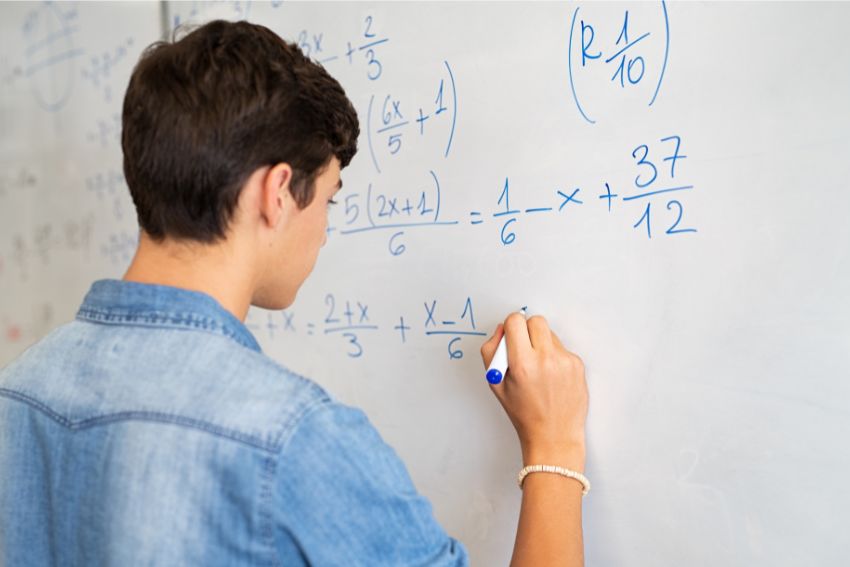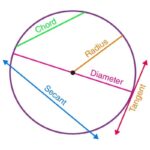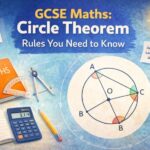Complete GCSE Maths Topic List 2025: What Students Need to Know
Are you preparing for your GCSE Maths exams in 2025? Understanding exactly what topics you need to study is the first step towards success. GCSE Maths is a core qualification that opens doors to further education. Most colleges, universities require at least a grade 4 (equivalent to the old grade C) in this essential subject.
In this guide, we’ll go through the all GCSE Maths topics you need to learn for both Foundation and Higher tiers. Whether you’re aiming for a passing grade or striving for a 9, knowing exactly what to revise will save you time and reduce stress. Let’s dive into the complete GCSE Maths topic list for 2025 and set you on the path to exam success.
What’s New for GCSE Maths in 2025?
Planning your GCSE Maths revision requires knowing what’s changed for 2025. Several important updates have been announced that will affect how you prepare and perform in your exams. Let’s look at the main changes you need to understand.
Will Formula Sheets Continue in 2025?
Yes, formula sheets will continue for GCSE Maths through 2027. Ofqual confirmed this change following a recent consultation, with 95% of respondents supporting the decision. These sheets will be identical to those used in 2024, giving you one less thing to worry about.
How Has The Exam Focus Changed?
The 2025 GCSE Maths syllabus emphasises problem solving and practical application. You’ll encounter more questions requiring you to apply mathematical concepts to real scenarios. This shift means you’ll need to practise contextual problems regularly, not just standard calculations.
When Will GCSE Maths Exams Happen?
GCSE Maths papers are scheduled for 15th May, 4th June and 11th June 2025. Paper 1 remains non-calculator, while Papers 2 and 3 permit calculator use. Each paper lasts 1 hour 30 minutes and contributes equally to your final grade.
The exam structure remains unchanged with three papers for both Foundation and Higher tiers. Therefore, choosing the appropriate tier based on your target grade remains crucial for maximising your potential mark.

How Are GCSE Maths Exams Structured?
Understanding the GCSE Maths exam structure helps you prepare more effectively. The exams are designed to test different mathematical skills across three separate papers. Let’s explore how these exams are organised for 2025.
Should You Take Foundation or Higher tier?
GCSE Maths offers two tiers to suit different ability levels. The Foundation tier covers grades 1-5, focusing on core mathematical concepts and simpler problems. Meanwhile, the Higher tier covers grades 4-9 and includes more difficult topics like advanced trigonometry and algebraic proof.
Your teacher will recommend the appropriate tier based on your performance. However, the decision ultimately balances ambition with realism. Aiming too high might leave you struggling with difficult content, while choosing Foundation limits your maximum grade to a 5.
What’s in The Three Exam Papers?
All students take three papers, each lasting 1 hour 30 minutes and worth 80 marks. Paper 1 is non-calculator, testing your ability to perform calculations mentally or using written methods. Papers 2 and 3 allow calculator use, assessing more complex problems and application.
The content across all three papers covers the six main topic areas: Number, Algebra, Ratio and Proportion, Geometry and Measures, Probability, and Statistics. Each paper contains a mix of question styles, from short answers to multi-step problems requiring extended working. You can view sample papers from AQA, Edexcel, or OCR to understand the format and question styles.
How Does the Grading System Work?
GCSE Maths uses the 9-1 grading system, with 9 being the highest grade possible. A grade 4 is considered a ‘standard pass’ (equivalent to the old grade C), while a grade 5 represents a ‘strong pass’. Most sixth forms and colleges require at least a grade 4 for further study.
The GCSE grade boundaries change slightly each year based on overall student performance. However, approximately 70% of marks typically secure a grade 4 on Foundation, while around 20% of marks achieve a grade 4 on Higher. Therefore, choosing the right tier significantly impacts your chances of success.
Core GCSE Maths Topics: Foundation Tier
The syllabus covers six main areas, each with specific skills you’ll need to demonstrate. Let’s break down what you need to know for each topic area.
Which Number Topics Must You Know?
Number forms the foundation of GCSE Maths, covering roughly 25% of Foundation tier papers. You’ll need to confidently work with:
- Rounding and estimation: Rounding to decimal places and significant figures; using approximation to estimate calculations.
- Key operations: Addition, subtraction, multiplication and division with positive and negative numbers, including decimals.
- Fractions and percentages: Converting between fractions, decimals and percentages; calculating percentage increases and decreases.
- Powers and roots: Understanding square and cube numbers; calculating with indices; using standard form for very large or small numbers.

What Algebra Concepts Will Be Tested?
Algebra accounts for approximately 20% of Foundation papers and tests your ability to work with unknown values. Main areas include:
Expressions and formulae – Simplifying expressions; substituting values into formulae; expanding single brackets.
Solving equations – Linear equations and simple quadratics; setting up and solving equations from word problems.
Sequences and graphs – Generating number sequences; plotting coordinates; interpreting straight-line graphs and recognising their equations.
How Important is Ratio and Proportion?
This area covers around 25% of Foundation papers and focuses on relationships between quantities:
- Ratio: Simplifying ratios; dividing amounts into given ratios; solving ratio problems.
- Proportion: Understanding direct and inverse proportion; solving proportion problems using the unitary method.
- Percentage changes: Calculating percentage increases and decreases; finding original values; working with simple interest.
- Speed, density and rates: Converting between units; calculating speed, distance and time.
What Geometry Topics Should You Revise?
Geometry and Measures make up about 15% of Foundation tier questions:
- Transformations: Reflecting, rotating and translating shapes; understanding enlargements.
- 2D shapes: Properties of triangles, quadrilaterals and circles; calculating angles in parallel lines and polygons.
- Area and perimeter: Finding the area and perimeter of rectangles, triangles, parallelograms and trapeziums.
- Volume and surface area: Calculating volumes of cuboids and prisms; finding surface areas of 3D shapes.
What Will You Need to Know About Probability
Probability questions typically constitute around 5% of the paper:
Probability diagrams: Creating and interpreting probability trees for successive events.
Basic probability: Calculating simple probabilities using fractions, decimals or percentages.
Combined events: Finding probabilities of multiple events using AND/OR rules.
Which Statistics Concepts are Essential?
Lastly, statistics accounts for approximately 10% of Foundation papers:
Data representation: Creating and interpreting pie charts, bar charts, line graphs and scatter graphs.
Averages and spread: Calculating mean, median, mode and range; comparing distributions.
Data collection: Understanding sampling methods; designing questionnaires; identifying bias in data.
Each topic builds on knowledge from earlier years, so regular revision of all areas is important.
Additional GCSE Maths Topics for Higher Tier
Higher tier GCSE Maths introduces several advanced topics. These challenging concepts often distinguish between grades 6-9 and require deeper mathematical understanding. Your GCSE Maths topic list needs to include these higher-level concepts if you’re aiming for top grades.
Advanced Number
Higher tier papers include more sophisticated number work, accounting for approximately 15% of questions. You’ll need to master surds and simplify expressions like √12 – √27, applying the laws of indices to solve complex problems involving negative and fractional powers.
Standard form calculations become more challenging, requiring you to multiply and divide numbers expressed in scientific notation without converting to ordinary numbers first. This skill is particularly useful in science subjects too.
The GCSE Maths topic list for Higher tier also includes working with exact values rather than decimal approximations, manipulating expressions that contain π, √2 or √3. Understanding upper and lower bounds extends your knowledge of rounding, requiring precise calculations with limits of accuracy.
Advanced Algebra
Algebra constitutes around 30% of Higher tier papers, with substantial additions beyond Foundation level. Quadratic equations feature prominently in the GCSE Maths topic list, requiring you to solve by factorising, using the formula, or completing the square.
Function notation introduces a more formal approach to algebra. You’ll interpret f(x) notation, combine functions to form composite functions, and find inverse functions. Graphical transformations extend your understanding of how equations relate to their graphs.
Algebraic proof represents a significant step up in difficulty on the GCSE Maths topic list. You’ll construct formal mathematical arguments to prove statements such as “the sum of three consecutive integers is always a multiple of 3.” This tests your ability to think logically and express mathematical reasoning clearly.
Advanced Geometry
Geometry at Higher tier (approximately 20% of papers) introduces several challenging concepts that build mathematical reasoning skills. Circle theorems form a key topic in the comprehensive GCSE Maths topic list, requiring you to apply rules about angles in circles to solve complex geometric problems.
Vector mathematics introduces a powerful tool for describing position and movement. You’ll add and subtract vectors, multiply by scalars, and use vector methods to prove geometric relationships, an elegant application of algebra to spatial problems.
Trigonometry extends beyond right-angled triangles to include the sine and cosine rules. These formulas allow you to solve any triangle when you know sufficient information about sides and angles. You’ll also calculate areas using the formula ½ab sin C.
Higher tier also extends other topics in the GCSE Maths topic list, with more complex proportion problems, harder statistical concepts, and more detailed probability calculations. Therefore, mastering Foundation content remains essential even as you tackle these advanced topics.
How to Use the Formula Sheet in 2025
For GCSE Maths exams through 2027, you’ll receive a formula sheet in the exam. Understanding how to use this resource effectively can help your performance on questions from across the GCSE Maths topic list.
What’s Included on the Sheet?
The 2025 formula sheet remains identical to the 2024 version. It provides area and volume formulas, Pythagoras’ theorem, and trigonometric ratios. Higher tier sheets also include circle theorems, the quadratic formula, and sine/cosine rules.
You’ll find formulas for geometric shapes, speed calculations, and density problems. The sheet covers most of the complex formulas from the GCSE Maths topic list, but basic formulas like area of a rectangle aren’t included.

Using it Effectively in Exams
Familiarise yourself with the sheet’s layout before exam day by practising with it regularly. When tackling formula-based questions, quickly locate the relevant formula, then copy it correctly into your working.
Remember that while the GCSE Maths topics requires knowledge of many formulas, the sheet only provides the equations, you still need to know when to apply them. The exam tests understanding rather than recall.
Formulas Still Worth Knowing
Even with the sheet provided, memorising common formulas saves valuable time. Basic area formulas, Pythagoras’ theorem, and simple trigonometric ratios are used frequently enough that knowing them automatically gives you an advantage.
Ultimately, understanding concepts remains more important than memorisation. The best approach is to practise applying formulas from the GCSE Maths topic list until the process becomes second nature.
Conclusion
The GCSE Maths topic list covers six core areas across both tiers, with Higher tier adding several advanced concepts. Understanding how these topics connect is more valuable than isolated knowledge of individual sections.
If you find certain topics particularly challenging, consider online GCSE Maths tutoring for personalised support. A good tutor can clarify difficult concepts and provide targeted practise that addresses your specific needs.
Start early and stay consistent! With dedicated preparation and the right support, you can approach your 2025 exams and achieve the grade you’re wishing for.
You Might Be Interested In
GCSE Maths – Everything You Need to Know
GCSE Maths Exam Boards Explained: Which One Is Best?








